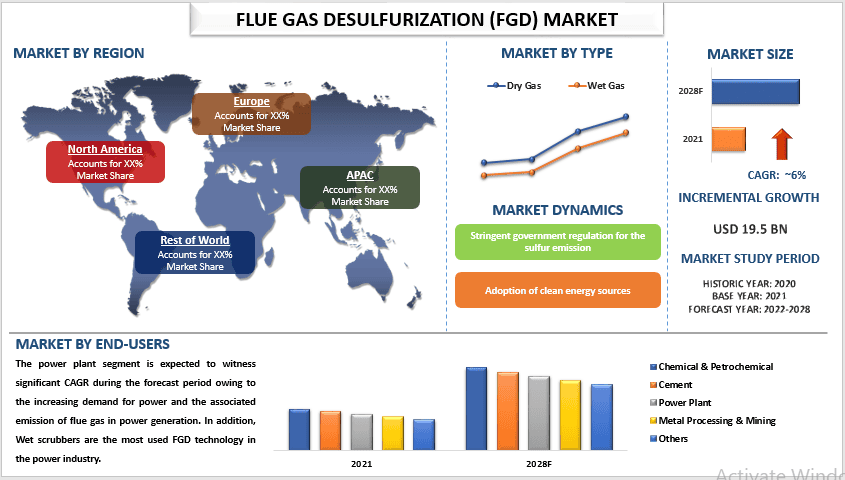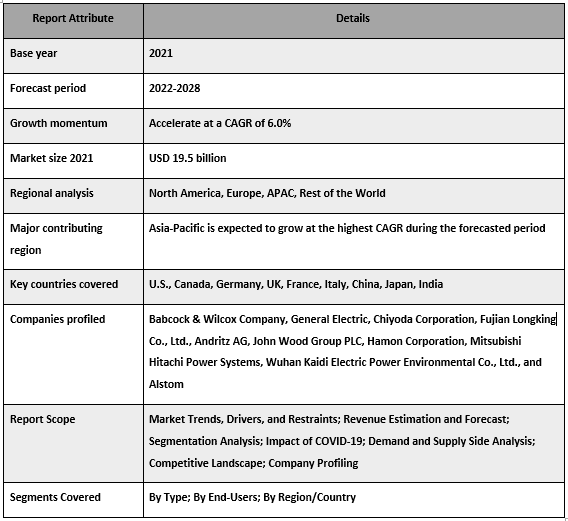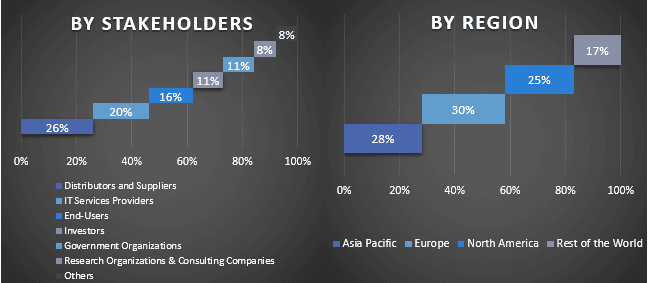- Trang chủ
- Về chúng tôi
- Ngành
- Dịch vụ
- Đọc
- Liên hệ với chúng tôi
Thị trường Khử Lưu huỳnh Khí thải (FGD): Phân tích và Dự báo Hiện tại (2022-2028)
Nhấn mạnh vào Loại (Khí ướt và Khí khô); và Người dùng cuối (Hóa chất & Hóa dầu, Xi măng, Nhà máy điện, Chế biến kim loại & Khai thác mỏ, và Các loại khác); và Khu vực/Quốc gia

Việc Khử Lưu huỳnh Khí thải (FGD)Thị trường được định giá 19,5 tỷ USD vào năm 2021 và dự kiến sẽ tăng trưởng với tốc độ CAGR là 6,0% từ năm 2022-2028.Do sự phụ thuộc cao hơn vào nhà máy điện đốt than để sản xuất năng lượng cũng như nhận thức ngày càng tăng liên quan đến phát thải lưu huỳnh.Khử Lưu huỳnh Khí thải (FGD) là một quá trình được sử dụng để loại bỏ điôxít lưu huỳnh (SO2) khỏi khí thải của các nhà máy điện sử dụng nhiên liệu hóa thạch, cũng như từ các quy trình công nghiệp khác tạo ra khí thải có chứa điôxít lưu huỳnh. Quá trình này còn được gọi là khử khí. Quá trình FGD liên quan đến việc sử dụng một chất tẩy rửa, thường là hỗn hợp nước và vôi hoặc đá vôi, phản ứng với điôxít lưu huỳnh trong khí thải để tạo ra sunfit canxi hoặc sunfat canxi. Sản phẩm thu được sau đó được loại bỏ khỏi luồng khí thải thông qua một loạt các quá trình vật lý và hóa học. Phương pháp FGD được sử dụng phổ biến nhất là khử khí ướt, trong đó khí thải được phun bằng chất tẩy rửa và sau đó đi qua một bộ loại bỏ sương để loại bỏ bất kỳ giọt chất tẩy rửa nào còn lại. Các phương pháp FGD khác bao gồm khử khí khô và khử khí bán khô. FGD là một quá trình quan trọng để giảm lượng điôxít lưu huỳnh thải vào khí quyển, vốn là một yếu tố chính gây ra mưa axit và các vấn đề môi trường khác.
Một số người chơi chính hoạt động trên thị trường bao gồm Babcock & Wilcox Company, General Electric, Chiyoda Corporation, Fujian Longking Co., Ltd., Andritz AG, John Wood Group PLC, Hamon Corporation, Mitsubishi Hitachi Power Systems, Wuhan Kaidi Electric Power Environmental Co., Ltd., và Alstom. Một số thương vụ M&A cùng với quan hệ đối tác đã được các công ty này thực hiện để tạo điều kiện cho khách hàng với các sản phẩm/công nghệ công nghệ cao và sáng tạo.
Thông tin chi tiết được trình bày trong Báo cáo
“Trong số các loại, phân khúc khí ướt chiếm thị phần chủ đạo của thị trường vào năm 2021”
Dựa trên loại, thị trường được chia thành hệ thống khí khô và khí ướt. Hệ thống khí ướt dự kiến sẽ đăng ký một thị phần đáng kể trong thị trường do việc kết hợp cao hơn trong các nhà máy điện, nồi hơi công nghiệp và các nguồn khác. Quá trình FGD ướt thường liên quan đến ba giai đoạn chính: hấp thụ, oxy hóa và loại bỏ sản phẩm phụ. Trong giai đoạn hấp thụ, khí thải được trộn với bùn nước của đá vôi hoặc vôi, hấp thụ điôxít lưu huỳnh. Trong giai đoạn oxy hóa, sunfit canxi bị oxy hóa để tạo thành sunfat canxi, sau đó được loại bỏ khỏi hệ thống. Cuối cùng, bất kỳ sản phẩm phụ nào được tạo ra trong quá trình này, chẳng hạn như thạch cao, sẽ được loại bỏ và xử lý. FGD ướt là một công nghệ được sử dụng rộng rãi để kiểm soát lượng khí thải điôxít lưu huỳnh từ các nhà máy điện và các cơ sở công nghiệp khác. Nó có hiệu quả cao, với hiệu suất loại bỏ lên đến 95% trở lên và cũng có chi phí tương đối thấp so với các công nghệ kiểm soát khác.
“Trong số những người dùng cuối, phân khúc nhà máy điện ghi nhận CAGR đáng kể trên thị trường trong năm 2021.”
Dựa trên người dùng cuối, thị trường được phân khúc thành hóa chất & hóa dầu, xi măng, nhà máy điện, chế biến kim loại & khai thác mỏ và các loại khác. Phân khúc nhà máy điện dự kiến sẽ chứng kiến CAGR đáng kể trong giai đoạn dự báo do nhu cầu điện ngày càng tăng và sự liên quan đến khí thải trong sản xuất điện. Ngoài ra, các thiết bị khử khí ướt là công nghệ FGD được sử dụng phổ biến nhất trong ngành điện. Chúng sử dụng chất lỏng (thường là bùn đá vôi) để hấp thụ SO2 từ khí thải. SO2 được hấp thụ phản ứng với chất lỏng để tạo thành canxi sunfat (thạch cao), có thể được sử dụng trong các ứng dụng công nghiệp khác nhau. Nhìn chung, các hệ thống FGD là một công nghệ thiết yếu để ngành điện giảm tác động đến môi trường và sức khỏe cộng đồng. Chúng giúp các nhà máy điện tuân thủ các quy định về môi trường và giảm lượng khí thải của các chất ô nhiễm độc hại.
“Châu Á-Thái Bình Dương chiếm ưu thế trên thị trường Khử Lưu huỳnh Khí thải (FGD) vào năm 2021”
Khu vực Châu Á-Thái Bình Dương là một thị trường lớn đối với các công nghệ FGD, do mức tiêu thụ than cao và nhu cầu kiểm soát khí thải SO2. Khu vực Châu Á-Thái Bình Dương dự kiến sẽ chứng kiến sự tăng trưởng đáng kể trong việc lắp đặt FGD trong những năm tới, được thúc đẩy bởi các quy định về môi trường nghiêm ngặt hơn và nâng cao nhận thức của công chúng về các tác động sức khỏe của ô nhiễm không khí. Trung Quốc và Ấn Độ là một trong những thị trường lớn nhất về công nghệ FGD trong khu vực, do công suất phát điện bằng than lớn của họ. Các quốc gia khác, chẳng hạn như Nhật Bản, Hàn Quốc và Úc, cũng đang đầu tư vào các công nghệ FGD để giảm lượng khí thải SO2 và các chất ô nhiễm khác.
Phạm vi Báo cáo Thị trường Khử Lưu huỳnh Khí thải (FGD)

Lý do để mua báo cáo này:
- Nghiên cứu bao gồm phân tích quy mô và dự báo thị trường được xác nhận bởi các chuyên gia trong ngành chính được ủy quyền.
- Báo cáo trình bày một cái nhìn tổng quan nhanh chóng về hiệu suất tổng thể của ngành.
- Báo cáo bao gồm một phân tích chuyên sâu về các đối tác trong ngành nổi bật với trọng tâm chính là tài chính kinh doanh chính, danh mục sản phẩm, chiến lược mở rộng và sự phát triển gần đây.
- Kiểm tra chi tiết về các động lực, hạn chế, xu hướng chính và cơ hội hiện có trong ngành.
- Nghiên cứu bao gồm toàn diện thị trường trên các phân khúc khác nhau.
- Phân tích cấp độ khu vực chuyên sâu về ngành.
Tùy chọn Tùy chỉnh:
Thị trường Khử Lưu huỳnh Khí thải (FGD) toàn cầu có thể được tùy chỉnh thêm theo yêu cầu hoặc bất kỳ phân khúc thị trường nào khác. Bên cạnh đó, UMI hiểu rằng bạn có thể có nhu cầu kinh doanh riêng, do đó, vui lòng kết nối với chúng tôi để có được một báo cáo hoàn toàn phù hợp với yêu cầu của bạn.
Mục lục
Phương pháp nghiên cứu để Phân tích Thị trường Khử Lưu huỳnh Khí thải (FGD) (2022-2028)
Phân tích thị trường lịch sử, ước tính thị trường hiện tại và dự báo thị trường trong tương lai của thị trường Khử Lưu huỳnh Khí thải (FGD) toàn cầu là ba bước chính được thực hiện để tạo và phân tích việc ứng dụng Khử Lưu huỳnh Khí thải (FGD) ở các khu vực chính trên toàn cầu. Nghiên cứu thứ cấp sâu rộng đã được tiến hành để thu thập số liệu thị trường lịch sử và ước tính quy mô thị trường hiện tại. Thứ hai, để xác thực những thông tin chi tiết này, nhiều phát hiện và giả định đã được xem xét. Hơn nữa, các cuộc phỏng vấn chính sâu rộng cũng đã được thực hiện với các chuyên gia trong ngành trên toàn bộ chuỗi giá trị của thị trường Khử Lưu huỳnh Khí thải (FGD) toàn cầu. Sau khi giả định và xác nhận số liệu thị trường thông qua các cuộc phỏng vấn chính, chúng tôi đã sử dụng phương pháp từ trên xuống/từ dưới lên để dự báo quy mô thị trường hoàn chỉnh. Sau đó, các phương pháp phân tích thị trường và tam giác dữ liệu đã được áp dụng để ước tính và phân tích quy mô thị trường của các phân khúc và phân khúc phụ của ngành liên quan. Phương pháp chi tiết được giải thích dưới đây:
Phân tích Quy mô Thị trường Lịch sử
Bước 1: Nghiên cứu chuyên sâu về các Nguồn thứ cấp:
Nghiên cứu thứ cấp chi tiết đã được tiến hành để có được quy mô thị trường lịch sử của thị trường Khử Lưu huỳnh Khí thải (FGD) thông qua các nguồn nội bộ của công ty nhưbáo cáo thường niên & báo cáo tài chính, bản trình bày hiệu suất, thông cáo báo chí, v.v.,và các nguồn bên ngoài bao gồmtạp chí, tin tức & bài viết, ấn phẩm của chính phủ, ấn phẩm của đối thủ cạnh tranh, báo cáo ngành, cơ sở dữ liệu của bên thứ ba và các ấn phẩm đáng tin cậy khác.
Bước 2: Phân khúc Thị trường:
Sau khi có được quy mô thị trường lịch sử của thị trường Khử Lưu huỳnh Khí thải (FGD), chúng tôi đã tiến hành phân tích thứ cấp chi tiết để thu thập thông tin chi tiết và thị phần thị trường lịch sử cho các phân khúc & phân khúc phụ khác nhau cho các khu vực chính. Các phân khúc chính được bao gồm trong báo cáo dưới dạng loại và người dùng cuối. Phân tích cấp quốc gia hơn nữa đã được tiến hành để đánh giá việc áp dụng tổng thể các mô hình thử nghiệm trong khu vực đó.
Bước 3: Phân tích Yếu tố:
Sau khi có được quy mô thị trường lịch sử của các phân khúc và phân khúc phụ khác nhau, chúng tôi đã tiến hành mộtphân tích yếu tốchi tiết để ước tính quy mô thị trường hiện tại của thị trường Khử Lưu huỳnh Khí thải (FGD). Hơn nữa, chúng tôi đã tiến hành phân tích yếu tố bằng cách sử dụng các biến phụ thuộc và độc lập như loại và người dùng cuối của thị trường Khử Lưu huỳnh Khí thải (FGD). Một phân tích kỹ lưỡng đã được tiến hành cho các kịch bản cung và cầu, xem xét các quan hệ đối tác hàng đầu, sáp nhập và mua lại, mở rộng kinh doanh và ra mắt sản phẩm trong lĩnh vực thị trường Khử Lưu huỳnh Khí thải (FGD) trên toàn cầu.
Ước tính & Dự báo Quy mô Thị trường Hiện tại
Đánh giá Quy mô Thị trường Hiện tại:Dựa trên những thông tin chi tiết có thể hành động từ 3 bước trên, chúng tôi đã đi đến quy mô thị trường hiện tại, những người chơi chính trên thị trường Khử Lưu huỳnh Khí thải (FGD) toàn cầu và thị phần của các phân khúc. Tất cả các phân chia tỷ lệ phần trăm cần thiết và phân tích thị trường đã được xác định bằng cách sử dụng phương pháp thứ cấp đã đề cập ở trên và đã được xác minh thông qua các cuộc phỏng vấn chính.
Ước tính & Dự báo:Đối với ước tính và dự báo thị trường, trọng số đã được gán cho các yếu tố khác nhau bao gồm động lực & xu hướng, hạn chế và cơ hội dành cho các bên liên quan. Sau khi phân tích các yếu tố này, các kỹ thuật dự báo có liên quan, tức là phương pháp từ trên xuống/từ dưới lên, đã được áp dụng để đưa ra dự báo thị trường cho năm 2028 cho các phân khúc và phân khúc phụ khác nhau trên các thị trường chính trên toàn cầu. Phương pháp nghiên cứu được áp dụng để ước tính quy mô thị trường bao gồm:
- Quy mô thị trường của ngành, tính theo doanh thu (USD) và tỷ lệ áp dụng của thị trường Khử Lưu huỳnh Khí thải (FGD) trên các thị trường chính trong nước
- Tất cả các tỷ lệ phần trăm, phân chia và phân tích các phân khúc và phân khúc phụ của thị trường
- Những người chơi chính trên thị trường Khử Lưu huỳnh Khí thải (FGD) toàn cầu về các sản phẩm được cung cấp. Ngoài ra, các chiến lược tăng trưởng được các công ty này áp dụng để cạnh tranh trong thị trường đang phát triển nhanh chóng
Xác thực Quy mô và Thị phần Thị trường
Nghiên cứu Sơ cấp:Các cuộc phỏng vấn chuyên sâu đã được tiến hành với các Nhà lãnh đạo Ý kiến Chính (KOL) bao gồm các Nhà điều hành Cấp cao (CXO/VPs, Trưởng phòng Kinh doanh, Trưởng phòng Tiếp thị, Trưởng phòng Vận hành, Trưởng phòng Khu vực, Trưởng phòng Quốc gia, v.v.) trên các khu vực chính. Các phát hiện nghiên cứu sơ cấp sau đó đã được tóm tắt và phân tích thống kê đã được thực hiện để chứng minh giả thuyết đã nêu. Đầu vào từ nghiên cứu sơ cấp đã được hợp nhất với các phát hiện thứ cấp, do đó chuyển thông tin thành những hiểu biết có thể hành động.
Phân chia những Người tham gia Chính ở các Khu vực Khác nhau

Kỹ thuật Thị trường
Kỹ thuật tam giác dữ liệu đã được sử dụng để hoàn thành ước tính thị trường tổng thể và để đưa ra các con số thống kê chính xác cho từng phân khúc và phân khúc phụ của thị trường Khử Lưu huỳnh Khí thải (FGD) toàn cầu. dữ liệu đã được chia thành một số phân khúc & phân khúc phụ sau khi nghiên cứu các thông số và xu hướng khác nhau trong các lĩnh vực sản phẩm, công nghệ và người dùng cuối trên thị trường Khử Lưu huỳnh Khí thải (FGD) toàn cầu.
Mục tiêu chính của Nghiên cứu Thị trường Khử Lưu huỳnh Khí thải (FGD) Toàn cầu
Các xu hướng thị trường hiện tại & tương lai của thị trường Khử Lưu huỳnh Khí thải (FGD) toàn cầu đã được xác định trong nghiên cứu. Các nhà đầu tư có thể thu được những hiểu biết chiến lược để dựa trên quyết định đầu tư của họ vào phân tích định tính và định lượng được thực hiện trong nghiên cứu. Các xu hướng thị trường hiện tại và tương lai đã xác định sức hấp dẫn tổng thể của thị trường ở cấp độ khu vực, cung cấp một nền tảng cho người tham gia công nghiệp để khai thác thị trường chưa được khai thác để hưởng lợi từ lợi thế người đi đầu. Các mục tiêu định lượng khác của các nghiên cứu bao gồm:
- Phân tích quy mô thị trường hiện tại và dự báo của thị trường Khử Lưu huỳnh Khí thải (FGD) về giá trị (USD). Ngoài ra, phân tích quy mô thị trường hiện tại và dự báo của các phân khúc và phân khúc phụ khác nhau
- Các phân khúc trong nghiên cứu bao gồm các lĩnh vực loại hình và người dùng cuối.
- Định nghĩa và phân tích khuôn khổ pháp lý cho ngành Khử Lưu huỳnh Khí thải (FGD)
- Phân tích chuỗi giá trị liên quan đến sự hiện diện của các trung gian khác nhau, cùng với phân tích hành vi của khách hàng và đối thủ cạnh tranh của ngành
- Phân tích quy mô thị trường hiện tại và dự báo của thị trường Khử Lưu huỳnh Khí thải (FGD) cho khu vực chính
- Các quốc gia chính của các khu vực được nghiên cứu trong báo cáo bao gồm Châu Á Thái Bình Dương, Châu Âu, Bắc Mỹ và Phần còn lại của Thế giới
- Hồ sơ công ty của thị trường Khử Lưu huỳnh Khí thải (FGD) và các chiến lược tăng trưởng được các nhà chơi trên thị trường áp dụng để duy trì trên thị trường đang phát triển nhanh chóng
- Phân tích chuyên sâu cấp độ khu vực của ngành
Liên quan Báo cáo
Khách hàng đã mua mặt hàng này cũng đã mua










